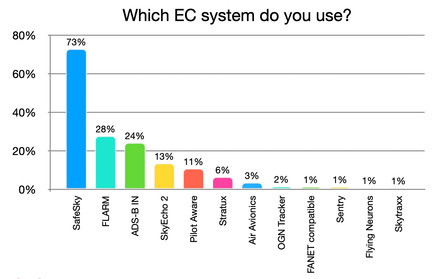Understanding eConspicuity: First findings SafeSky's Survey.
- Ingrid

- Feb 5, 2024
- 4 min read
Updated: Oct 17, 2024
In December 2023 and January 2024, SafeSky conducted a thorough survey on eConspicuity. The survey, open to all pilots both within and outside the SafeSky community, received high response. Participants from 25 countries shared insights on their practices, knowledge, and system appreciation.
The results provide a well-balanced and transparent perspective on eConspicuity from the entire pilot community, in Europe and beyond. It's important to note that the SafeSky community was probably highly responsive, making it prominently represented in this survey, particularly in SafeSky-related questions.
A big thank you to all participants for contributing to our shared goal of creating a safer sky, together.
Overall findings
Participants demographics

Over 50% of the participants are aged 60 and above, confirming flying remains a recreation with entry barriers (such as time and financial investment).
Participants' flying experience is evenly distributed across beginners, experienced, and proficient pilots.
Representation from 25 countries, with notable participation from France, the UK, and Germany, is in line with the European distribution of the general aviation community.
Aircraft classes are very diverse, with significant representation in microlights (29%), planes (28%), (para)gliders (18%), and an emerging presence of UAVs (4%), showcasing the new variety in sky occupants.
See & Avoid limitations
There is a transparent acknowledgment that applying "See & Avoid" rules is challenging.
Major barriers include limited external visibility and in-cockpit activities, with 71% admitting not having the recommended 80%+ time to look outside!
This leads to (high) concern (59%) about experiencing an airprox (risk of collision), supported by 61% confirming having encountered at least one airprox.
Airprox pilot testimonials
"Below 500ft, while flying my paraglider, I encountered 2 military helicopters at 400ft vertical." | "I once had a near collision with a drone, flying at 1.000 feet!!! Reported it immediately to Brussel info." |

Airproxes predominantly occur below 2500ft, in the circuit, or when approaching an airfield, with a surprising 16% experiencing them above 2500ft.
Pilots often refrain from reporting airmisses (73%) due to administrative hassle, lack of knowledge about the process, or reporting them elsewhere.
How and when to declare an airprox? AIRPROX REPORTING "If you consider that your aircraft has been endangered during flightby the proximity of another aircraft such that a risk of collision existed, report it by radio. If this is not possible, immediately after landing telephone or by other means contact the Air Traffic Service unit." Source: EASA. Standard message: "AIRPROX, G-xxxx wants to report an AIRPROX". |
eConspicuity (EC) systems
76% of participants use an eConspicuity system, with variations across countries, France showing the lowest use (only 66%), and the UK standing out with 93%.
SafeSky is the most popular EC system (73%), partly explained by the likely high survey participation rate of the SafeSky community, but also confirming its high adoption level.
Other popular systems include FLARM (28%), ADS-B in (24%), SkyEcho 2 (13%), PilotAware (11%), and Stratux (6%).
Of all pilots using an EC device, 55% use one single device. Pilots using multiple systems combine mostly SafeSky with FLARM (11%) or ADS-B (10%), all three combined (7%), or SafeSky combined with Pilot Aware (6%).
eConspicuity (EC) system concerns and limitations

22% of pilots don't know or are unsure which traffic their EC device will display while 64% lack full confidence in their EC device's ability to detect an airprox.
This lack of knowledge and confidence applies to all systems and combinations.
72% of pilots confirm having noticed converging aircraft their device did not see.
Conversely, in 83% of cases, EC systems spotted aircraft before pilots did.
This emphases the need to complement both human and electronic vision.

What pilots miss most in terms of EC, is all pilots not being electronically visible, closely followed by the lack of interoperability between systems.
"The lack of obligation for all users of the sky to be conspicuous is THE issue."EFB (Electronic Flight Bags, navigation software)

SkyDemon is the most used EFB (46%), especially in the UK (73% of users), followed by SDVFR (23%) mainly used in France, ForeFlight, AirNavPro, Garmin Pilot, and EasyVFR.
33% declare using several EFBs, while 5% declare not using any EFB.
Conclusion |
The survey reveals key challenges and opportunities to improve air safety. |
|
A wealth of opportunities for a collective effort between pilots, associations and solution developers to together create a safer sky! |
Now what? What's next?
In our upcoming newsletters, we will delve into more detailed survey topics, and of course, SafeSky feedback.
We will engage with the European Union Aviation Safety Agency (EASA) and our other partners to individually and collectively address air safety improvements.
We want to thank again all pilots for taking the time for transparently sharing their experience with eConspicuity.














